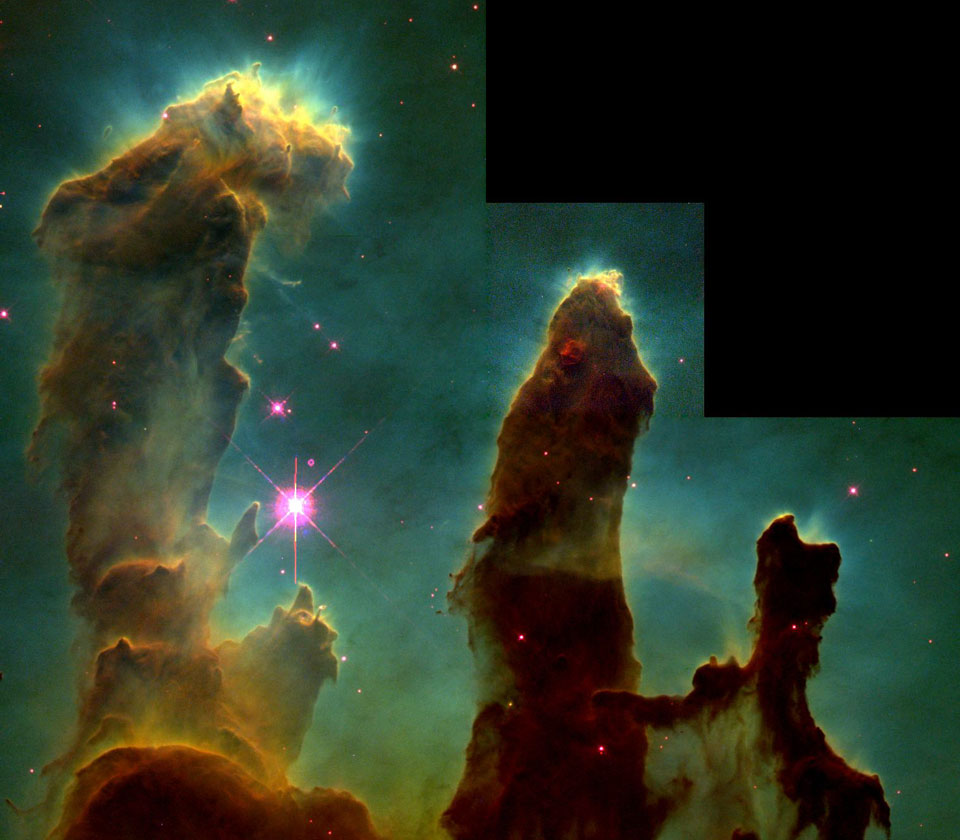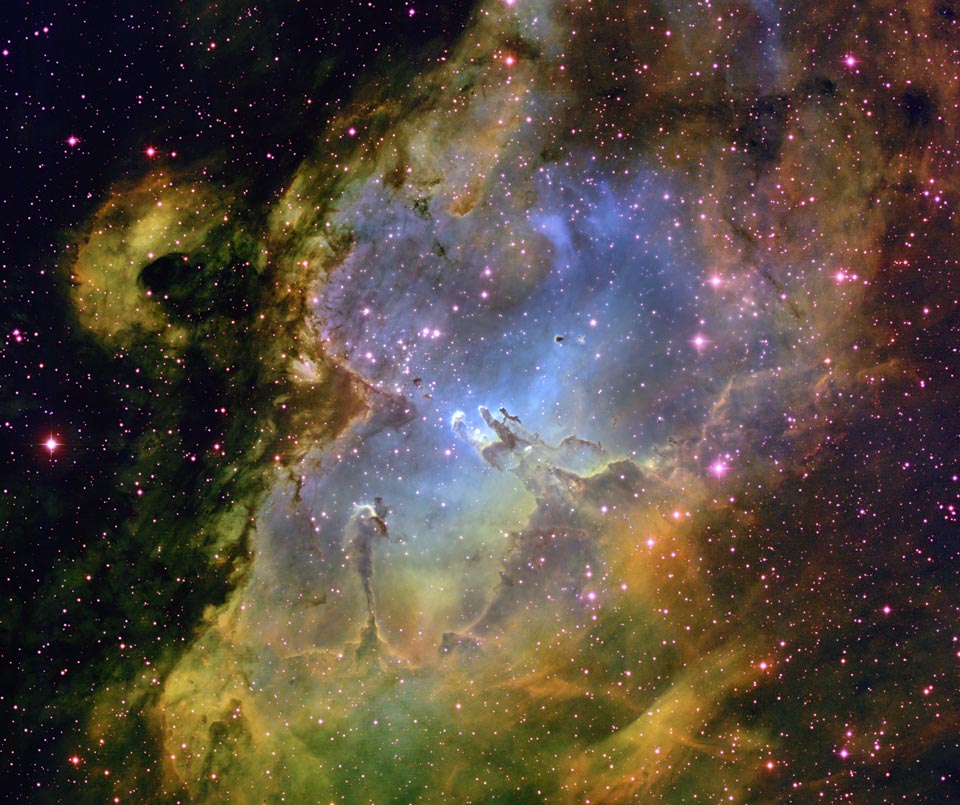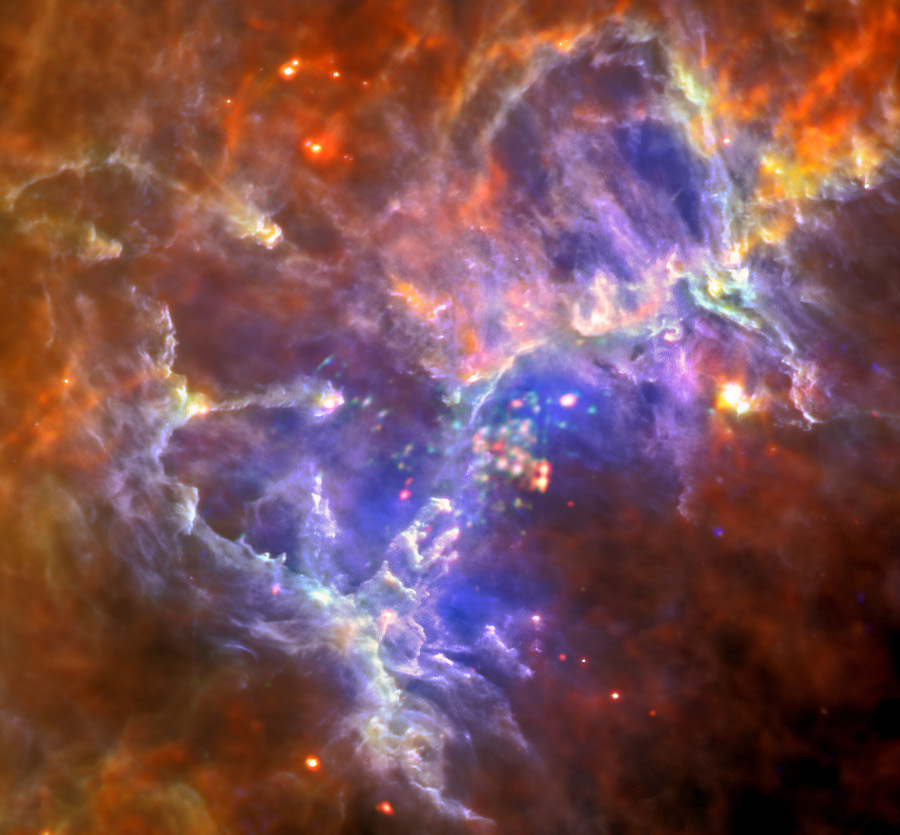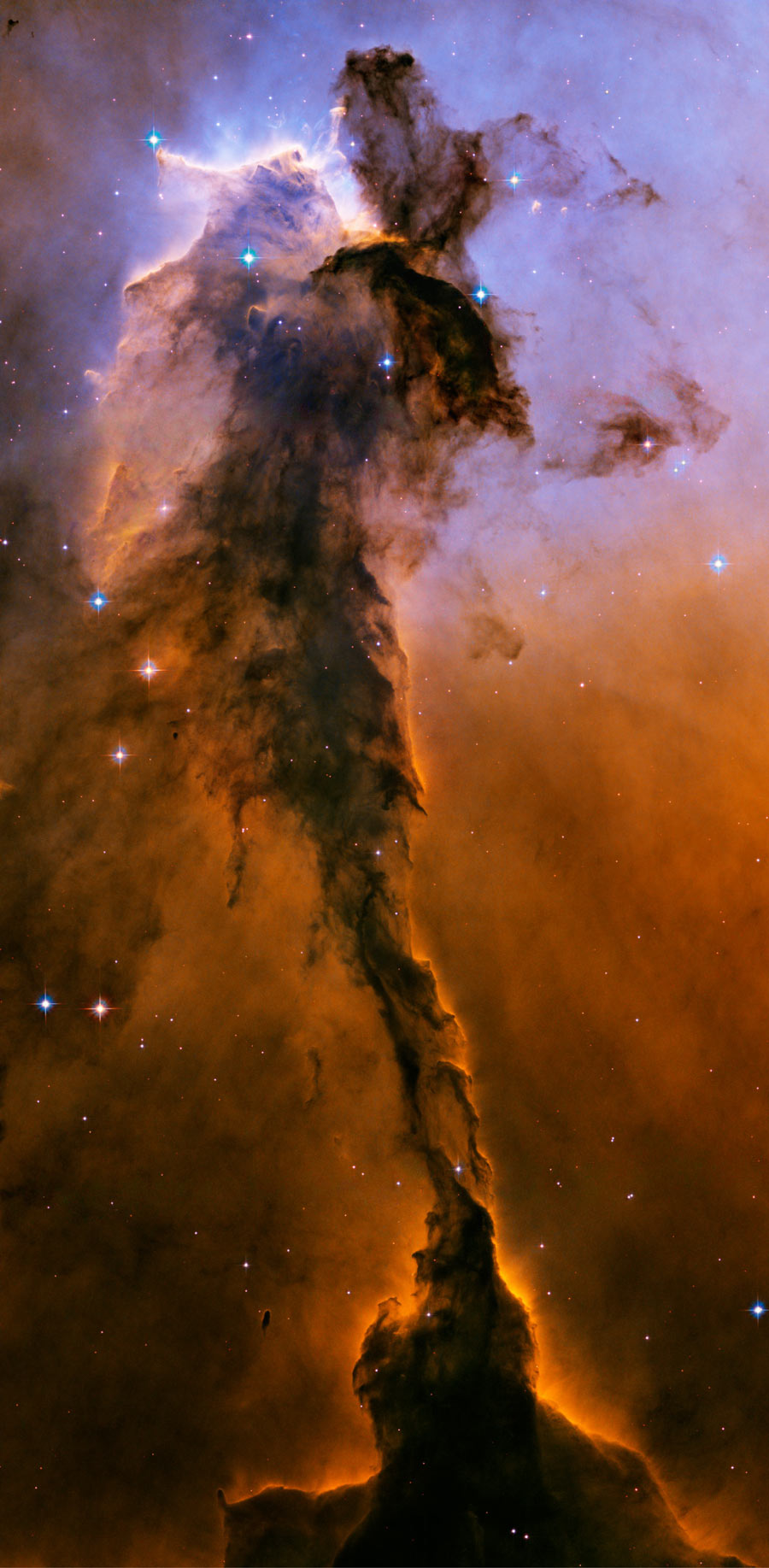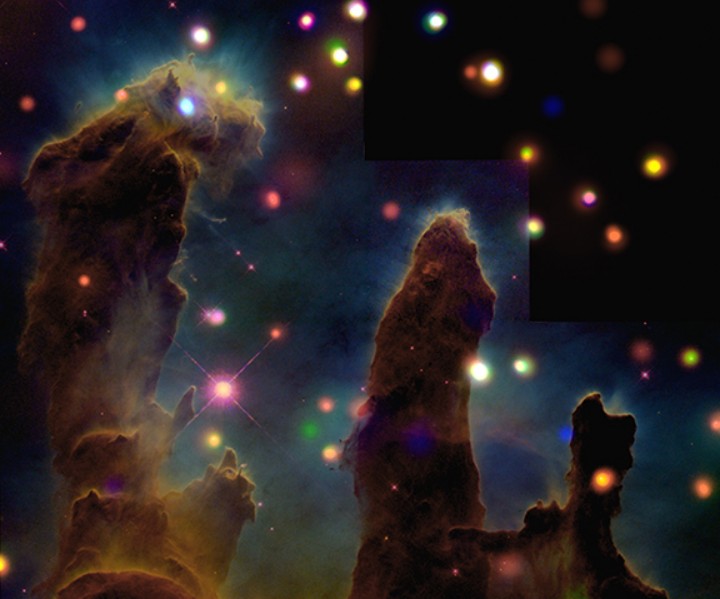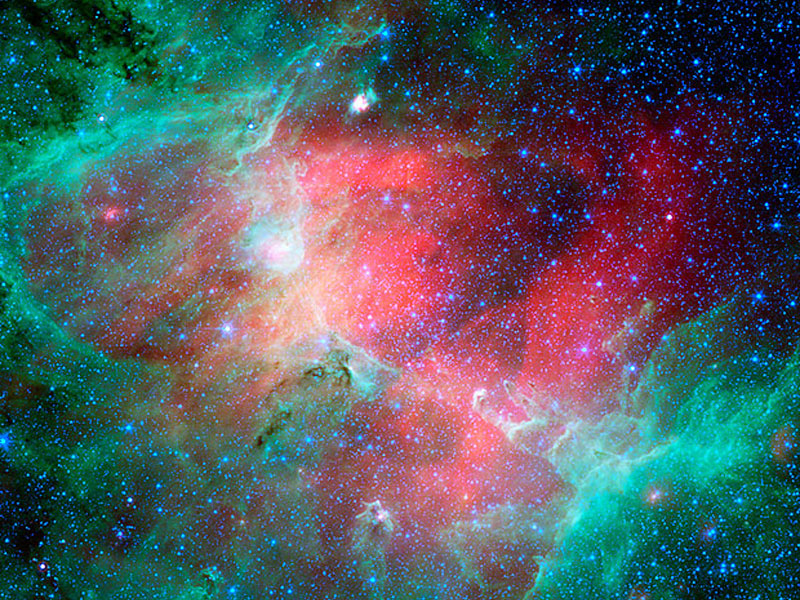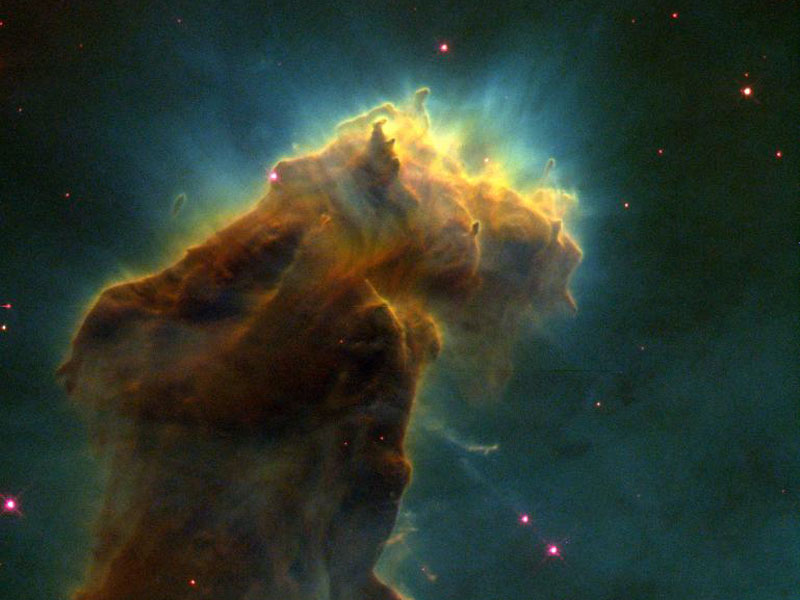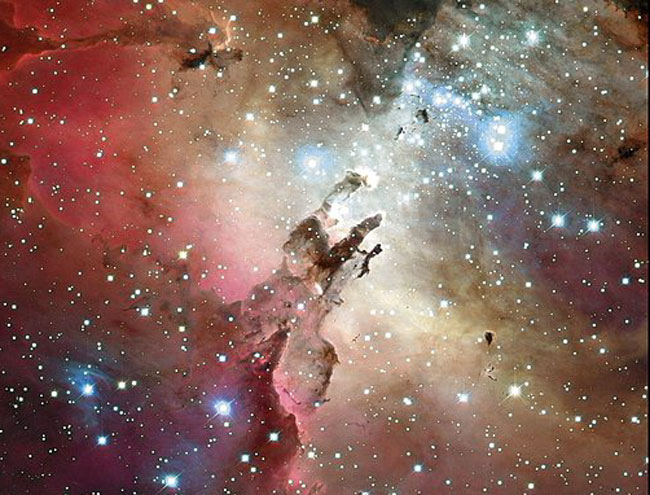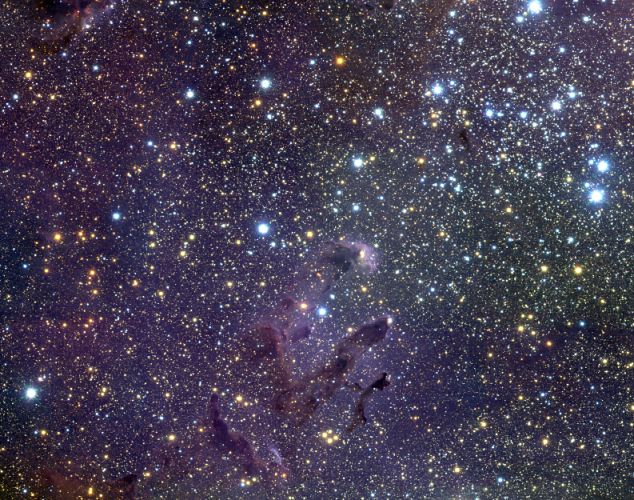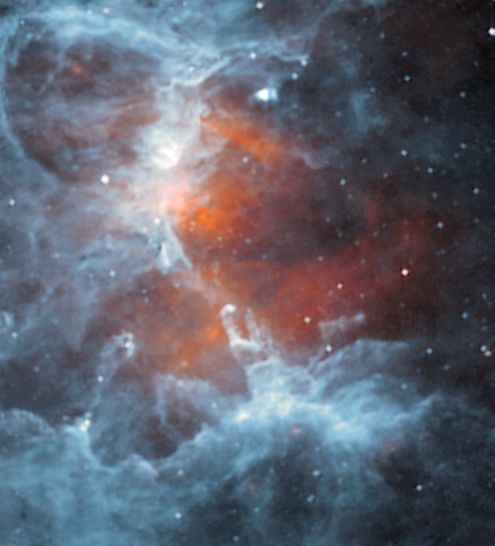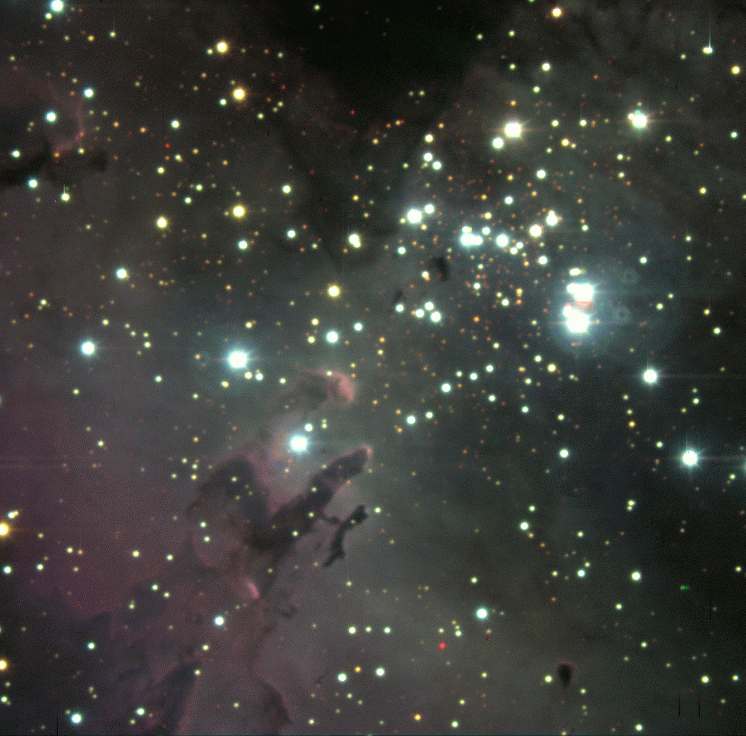All titles are clickable and link to the original APOD page. Click on an image for a larger view of it.
2012 July 22
2010 March 28
2007 February 18 It was one of the most famous images of the 1990s. This image, taken with the Hubble Space Telescope in 1995, shows evaporating gaseous globules (EGGs) emerging from pillars of molecular hydrogen gas and dust. The giant pillars are light years in length and are so dense that interior gas contracts gravitationally to form stars. At each pillars' end, the intense radiation of bright young stars causes low density material to boil away, leaving stellar nurseries of dense EGGs exposed. The Eagle Nebula, associated with the open star cluster M16, lies about 7000 light years away. The pillars of creation were imaged again in 2007 by the orbiting Spitzer Space Telescope in infrared light, leading to the conjecture that the pillars may already have been destroyed by a local supernova, but light from that event has yet to reach the Earth.
2012 April 16
2009 February 8
2006 February 26
2004 October 24
2003 September 21
2002 June 11 From afar, the whole thing looks like an Eagle. A closer look at the Eagle Nebula, however, shows the bright region is actually a window into the center of a larger dark shell of dust. Through this window, a brightly-lit workshop appears where a whole open cluster of stars is being formed. In this cavity tall pillars and round globules of dark dust and cold molecular gas remain where stars are still forming. Already visible are several young bright blue stars whose light and winds are burning away and pushing back the remaining filaments and walls of gas and dust. The Eagle emission nebula, tagged M16, lies about 6500 light years away, spans about 20 light-years, and is visible with binoculars toward the constellation of the Serpent (Serpens). This picture combines three specific emitted colors and was taken with the 0.9-meter telescope on Kitt Peak, Arizona, USA.
2012 February 3
2011 August 21
2007 December 9
2005 April 25 The dust sculptures of the Eagle Nebula are evaporating. As powerful starlight whittles away these cool cosmic mountains, the statuesque pillars that remain might be imagined as mythical beasts. Pictured above is one of several striking dust pillars of the Eagle Nebula that might be described as a gigantic alien fairy. This fairy, however, is ten light years tall and spews radiation much hotter than common fire. The greater Eagle Nebula, M16, is actually a giant evaporating shell of gas and dust inside of which is a growing cavity filled with a spectacular stellar nursery currently forming an open cluster of stars. The above image in scientifically re-assigned colors was released in 2005 as part of the fifteenth anniversary celebration of the launch of the Hubble Space Telescope.
2009 July 10 What lights up this castle of star formation? The familiar Eagle Nebula glows bright in many colors at once. The above image is a composite of three of these glowing gas colors. Pillars of dark dust nicely outline some of the denser towers of star formation. Energetic light from young massive stars causes the gas to glow and effectively boils away part of the dust and gas from its birth pillar. Many of these stars will explode after several million years, returning most of their elements back to the nebula which formed them. This process is forming an open cluster of stars known as M16.
2008 February 27 Bright blue stars are still forming in the dark pillars of the Eagle Nebula. Made famous by a picture from the Hubble Space Telescope in 1995, the Eagle Nebula shows the dramatic process of star formation. The above picture taken by a 0.8-meter telescope in the Canary Islands captures part of M16, the open cluster of stars that is being created. The high amount of detail in the above image results from it being taken only in specific colors of light emitted by hydrogen, oxygen, and sulfur. The bright blue stars of M16 have been continually forming over the past 5 million years, most recently in the famous central gas and dust columns that have been informally dubbed the Pillars of Creation and the Fairy. Light takes about 7,000 years to reach us from M16, which spans about 20 light years and can be seen with binoculars toward the constellation of the Serpent (Serpens).
2007 February 24
2007 January 11 In visible light, the whole thing looks like an eagle. The region was captured recently in unprecedented detail in infrared light by the robotic orbiting Spitzer Space Telescope (SSC). Shown above, the infrared image allows observers to peer through normally opaque dust and so better capture the full complexity of the Eagle Nebula star forming region. In particular, the three famous pillars near the image center are seen bathed in dust likely warmed by a supernova explosion. The warm dust is digitally assigned the false color of red. Also visible, near the bottom of the image, is ten light-year long pillar sometimes dubbed the Fairy of Eagle Nebula. The greater Eagle emission nebula, tagged M16, lies about 6500 light years away, spans about 20 light-years, and is visible with binoculars toward the constellation of Serpens.
2006 October 22
2001 August 12
2000 April 2
1998 February 28
1995 November 7 Where do stars form? One place, star forming regions known as "EGGs", are uncovered at the end of this giant pillar of gas and dust in the Eagle Nebula (M16). EGGs, short for evaporating gaseous globules, are dense regions of mostly molecular hydrogen gas that fragment and gravitationally collapse to form stars. Light from the hottest and brightest of these new stars heats the end of the pillar and causes further evaporation of gas - revealing yet more EGGs and more young stars. This picture was taken by the Wide Field and Planetary Camera on board the Hubble Space Telescope.
2005 April 24
2003 October 26
2001 November 25
2000 September 24
1999 May 2
1998 April 12 Newborn stars are forming in the Eagle Nebula. This image, taken with the Hubble Space Telescope in 1995, shows evaporating gaseous globules (EGGs) emerging from pillars of molecular hydrogen gas and dust. The giant pillars are light years in length and are so dense that interior gas contracts gravitationally to form stars. At each pillars' end, the intense radiation of bright young stars causes low density material to boil away, leaving stellar nurseries of dense EGGs exposed. The Eagle Nebula, associated with the open star cluster M16, lies about 7000 light years away.
2003 February 13 Bright blue stars are still forming in the dark pillars of the Eagle Nebula. Made famous by a picture from the Hubble Space Telescope in 1995, the Eagle Nebula shows the dramatic process of star formation. To the upper right of the nebula in the above picture lies the heart of the open cluster M16. The bright blue stars of M16 have been continually forming over the past 5 million years, most recently in the famous central gas and dust pillars known as elephant trunks. Light takes about 7000 years to reach us from M16, which spans about 20 light years and can be seen with binoculars toward the constellation of Serpens.
2002 January 4 The head of an interstellar gas and dust cloud is shown here in false-color, a near-infrared view recorded by astronomers hunting for stars within M16's Eagle Nebula. Made famous in a 1995 Hubble image of the 7,000 light-year distant star forming region, the pillar-shaped cloud's surface was seen to be covered with finger-like evaporating gaseous globules (EGGs). The near-infrared image penetrates the obscuring dust cloud's edges. But the cloud's core appears dark and opaque, even at these relatively long wavelengths. Still, this image, made with ESO's Antu telescope, reveals a massive, bright yellow star not directly detected in the visible light Hubble data. This very young star lights up the small bluish nebula with a dark, twisted central stripe, just above it. Below and to its right are several much fainter, less massive stars also not seen in visible light - newborn stars which lie within the Eagle's EGGs. These newborn stars may have already been collapsing, forming from material inside the nebula before the intense radiation from other, nearby, emerging hot stars eroded and sculpted the dramatic pillars and EGGs. In any event, as the dusty clouds are eroded away, stars still forming will be cutoff from their reservoir of star stuff. Further growth and even the development of planetary systems will likely be seriously affected.
2002 January 3 The Hubble Space Telescope's 1995 image of pillars of dust and gas, light-years long, within the Eagle Nebula (M16) was sensational. The three prominent pillars in that close-up visible light picture also appear below center in this wide-field mosaic along with massive, bright, young stars of cluster NGC 6611 (upper right), whose winds and radiation are shaping the dusty pillars. Made in near infrared light with the European Southern Observatory's 8.2-meter Antu telescope, this wide-field image makes the pillars seem more transparent, as the longer wavelengths partially penetrate the obscuring dust. While the Hubble image showed the pillars' startling surface details - over 70 opaque, finger-shaped lumps of material dubbed evaporating gaseous globules or EGGs, the near infrared view has allowed astronomers to peer inside. Comparing the two views reveals that nearly a dozen of the EGGs do indeed have stars embedded near their tips. More stars within EGGs may be detected if longer wavelength observations of the region are made. But which came first, the stars or the EGGs?
2001 September 14 Stars are born in M16's Eagle Nebula, a stellar nursery 7,000 light-years from Earth toward the constellation Serpens. The striking nebula's star forming pillars of gas and dust are familiar to astronomers from images at visible wavelengths, but this false-color picture shows off the nebula in infrared light. Data from ESA's Infrared Space Observatory satellite (ISO) was used to construct the detailed two color image, dominated by infrared emission from clouds of interstellar material at temperatures below -100 degrees Celsius. Blue colors highlight emission thought to indicate the presence of complex carbon molecules, known on planet Earth as PAHs, while red colors trace emission from cold, microscopic dust grains. Hot young stars are formed as this frigid material condenses under the influence of gravity. Once begun, the process takes only tens of thousands of years for truly massive stars and up to tens of millions of years for low mass stars like the Sun.
1997 July 30 What lights up this castle of star formation? The familiar Eagle Nebula glows much like a neon sign, but in many colors at once. The above photograph is a composite of three of these glowing gas colors. In particular the glowing red Sulfur gas of the nebula nicely outlines some of the denser star forming knots. Energetic light from young massive stars causes the gas to glow and effectively boils away part of the dust and gas from its birth pillar. Many of these stars will explode after several million years, returning most of their elements back to the nebula which formed them. This process is forming an open cluster of stars known as M16.
1997 July 18 Bright blue stars are still forming in the red pillars of the Eagle Nebula. Made famous by a picture from the Hubble Space Telescope in 1995, the Eagle Nebula shows the dramatic process of star formation. To the upper right of the nebula in the above picture lies the heart of the open cluster M16. This picture closely depicts the true colors of the stars and nebula. The bright blue stars of M16 are continually forming from the Eagle Nebula gas, most recently in the famous gas and dust pillars seen below the photo's center. Of all the young stars in M16, the most massive shine the brightest and the bluest. A typical age for a star in this cluster is about 5 million years, making them only 1/1000 the age of our Sun. Light takes about 7000 years to reach us from M16.
1997 January 18
1995 November 1
1995 November 6 How do stars form? This stunning picture taken recently by the Hubble Space Telescope gives us a first hand glimpse. Here evaporating gaseous globules (EGGs) are captured emerging from pillars of molecular hydrogen and dust in the Eagle Nebula (M16). These pillars, dubbed "elephant trunks," are light years in length and are so dense that interior gas gravitationally contracts to form stars. At each pillars' end, the intense radiation of bright young stars causes low density gas to boil away, leaving stellar nurseries of dense EGGs exposed.
